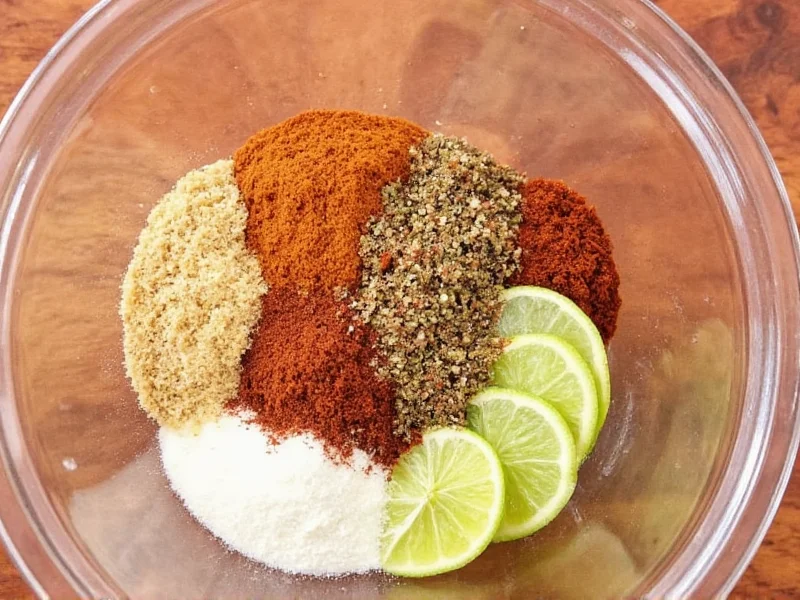Creating your own taco seasoning at home is simpler than you might think and offers significant advantages over store-bought versions. This easy homemade taco seasoning recipe gives you complete control over ingredients, allowing you to adjust heat levels, eliminate unwanted additives, and create a fresher, more vibrant flavor profile for your favorite Mexican-inspired dishes.
Why Make Your Own Taco Seasoning
Commercial taco seasoning packets often contain fillers, excessive sodium, and preservatives like MSG that can compromise both health and flavor. When you make your own taco seasoning from scratch, you benefit from:
- Fresher flavor - Spices lose potency over time; homemade ensures maximum aroma and taste
- Customization - Adjust heat level and flavor profile to your exact preference
- Healthier ingredients - Avoid anti-caking agents, excessive salt, and artificial additives
- Cost savings - Homemade costs pennies per batch compared to store-bought packets
- Eco-friendly - Reduce packaging waste from single-use seasoning packets
Essential Taco Seasoning Ingredients Explained
Understanding each component helps you create the best taco seasoning mix recipe possible. Here's why each ingredient matters:
| Ingredient | Function | Substitution Options |
|---|---|---|
| Chili powder | Base flavor and color | Ancho chili powder for deeper flavor |
| Cumin | Earthy, distinctive taco flavor | None - essential for authentic taste |
| Paprika | Rich color and mild sweetness | Smoked paprika for depth |
| Garlic powder | Savory depth | Fresh minced garlic (add when cooking) |
| Onion powder | Sweetness and complexity | Fresh minced onion (add when cooking) |
Step-by-Step Taco Seasoning Preparation
Follow these simple steps for perfect taco seasoning every time:
- Gather all spices in their measured amounts
- Use a small bowl that allows thorough mixing
- Whisk ingredients together for 1-2 minutes to ensure even distribution
- Transfer to an airtight container immediately to preserve freshness
- Label with date and recipe name
The key to a successful taco seasoning recipe without MSG is proper mixing technique. Incomplete blending results in uneven flavor distribution where some bites taste overwhelmingly of one spice while others lack flavor entirely.
Customizable Taco Seasoning Variations
One of the greatest advantages of making your own seasoning is the ability to customize. Try these popular variations:
Mild Family-Friendly Version
Reduce red pepper flakes to 1/4 teaspoon and increase paprika to 3 teaspoons. Perfect for children or those sensitive to spice.
Spicy Restaurant-Style
Add 1/2 teaspoon cayenne pepper and 1/4 teaspoon ground chipotle for intense heat with smoky depth. Ideal for those who enjoy authentic Mexican taco seasoning recipe heat levels.
Authentic Mexican-Inspired Blend
Omit garlic and onion powder (less traditional in Mexico), add 1/2 teaspoon Mexican oregano, and include 1 dried guajillo pepper (stemmed, seeded, and finely ground). This version stays truer to regional flavors.
Proper Storage for Maximum Freshness
Understanding how long does homemade taco seasoning last is crucial for maintaining quality. Follow these storage guidelines:
- Store in an airtight glass or metal container (plastic can absorb odors)
- Keep in a cool, dark place away from heat sources
- Properly stored, your mix remains fresh for 3-4 months
- After 4 months, potency gradually decreases but remains safe to use
- Never store near the stove or oven where heat and moisture fluctuate
Check freshness by rubbing a small amount between your fingers and smelling. If the aroma is weak or musty, it's time to make a new batch. Proper storage ensures your gluten-free taco seasoning recipe maintains its vibrant flavor profile.
Using Your Homemade Taco Seasoning
Knowing how much taco seasoning per pound of meat makes a significant difference in your final dish. For perfect results:
- Use 2-3 tablespoons of seasoning per pound of ground meat
- Add seasoning after meat is nearly cooked through
- Include 1/2 cup water when cooking to help spices penetrate
- Cook for 5-7 minutes after adding seasoning to develop flavors
This versatile mix works beyond traditional tacos. Try it in:
- Taco salads and nachos
- Bean dishes and rice
- Marinades for chicken or fish
- Roasted vegetables
- Homemade tortilla chips seasoning
Troubleshooting Common Issues
Even simple recipes can encounter problems. Here's how to fix common taco seasoning issues:
Seasoning Too Salty
If your mix tastes too salty, double the recipe without additional salt next time. When cooking, reduce added salt elsewhere in your recipe and include a small potato while cooking meat to absorb excess salt.
Lacking Depth of Flavor
Boost flavor by toasting whole cumin seeds before grinding, adding 1/4 teaspoon cocoa powder, or including a small pinch of cinnamon. For the best taco seasoning mix recipe, freshness of individual spices matters most.
Seasoning Clumping
Prevent clumping by ensuring all spices are completely dry before mixing. Add 1/2 teaspoon cornstarch or rice grains to the container to absorb moisture. Shake well before each use.











 浙公网安备
33010002000092号
浙公网安备
33010002000092号 浙B2-20120091-4
浙B2-20120091-4